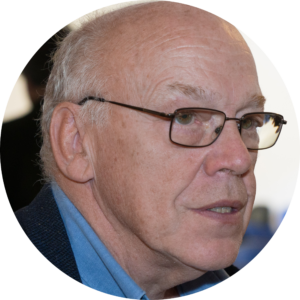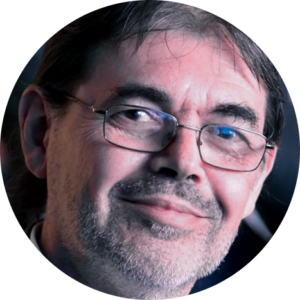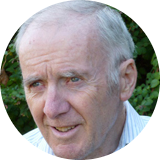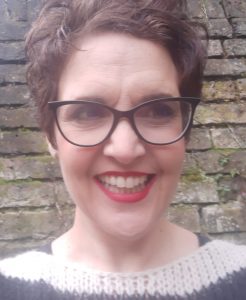Words: Maddalena Vario, GARR
It is often said that research networks stand on the shoulders of giants – and surely one of those giants was Howard Davies.
From the first international research network HEPNET to the association of European research networks RARE, up to the creation of DANTE, now GÉANT, Howard Davies has always played a leading role, making the history of the research network.
We would like to honour him, through the memories of Fernando Liello and Claudio Allocchio, two network experts who made GARR history and were lucky enough to work side by side with Howard.
Fernando Liello

We had both worked at CERN as researchers, so the mindset that was leading each and every choice we made was to always see the network at the service of users. For him it was essential to identify what users needed and to be able to interpret their needs, even when they were not clearly expressed, and then move on to the technical part. He was open-minded, and a man of culture . I remember that the name DANTE was chosen when he showed up one day at a meeting with a bottle of Dante olive oil. He was a perfect British gentleman and, as such, he had a habit of speaking softly. I once told him as a joke: “Howard, I realise that speaking softly is a sign of education in the UK, but the problem is that we don’t hear you!” At one point they even had to give him a portable battery-operated speaker that could stand in front of him when speaking.
He was a great diplomat and mediator. He got along well with people, he liked to talk with them. He had a great ability to listen and he really listened, even when his interlocutors had different points of view. He was able to understand their needs beyond the specific solution they sought and his great ability was to satisfy those needs , even through a different solution. In a way I was his complement, I agreed with this strategy and as chairman of the Committee I took the risk of having things approved. Then there was the other executive director, Dai Davies, who had a more commercial mentality. He was selected because the two were different but complementary: this choice of personalities proved to be strategic and in fact made possible the creation of precious synergies and mutual reinforcements.
It was also important for him that young people knew the history of things and in fact he was chief editor of one of the first books written on the history of research networks: “A History of International Research Networking: The People who Made it Happen”. He started writing the book when he was still working and then it was published when he retired.
For sure I can say that Howard, with his pioneering vision of research networks and his ability to keep everything in balance, has left a great void.”
Claudio Allocchio

“Howard was first of all a scientist, who understood what networks were made for. I met him in the 1980s at CERN, I was just starting out my career and he already knew exactly that the network was a tool for doing research. I remember he was working with Enzo Valente (the founder of the Italian Research and Education Network, GARR) who was involved in physics experiments; with Peter Villemoes, who was head of the Nordunet research network for many years; and with Francois Flukinger, from CERN, who was in charge of the computer centre. They were mainly physicists, who needed to exchange data and consequently they were building the first international research network HEPnet. At some point, Howard and many others realised that they needed to team up to get the European Commission to fund the construction of a pan-European network backbone. Since 1986 there was already RARE, the first association of the European research networks, which later became TERENA and finally the GÉANT Association, but it was necessary to create something specific, a detached division, in order to have the right structure to create and manage a large and international backbone: that’s how DANTE was born. He became executive director of DANTE along with Dai Davies and I remember we used to call them “the Davies twins” as a joke. In reality they were very different but absolutely complementary and together they formed an excellent team. One was a great diplomat, the other a great manager and a skilled salesman and, working side by side, they knew how to make DANTE work. Perhaps Howard was a little bit embarrassed by this juxtaposition, I would say bizarre, with his namesake Dai, since they had a completely different mentality, but he didn’t show it.
He had a great sense of humour and knew how to laugh at himself too, a quality I would say rare to meet. I remember that he was always wearing tweed, with a sweater without any tie, even in the most formal meetings. He was a true British gentleman and a gentleman agreement had the same value as a signed one with him. He was a curious person, even if he didn’t show it, he always wanted to know what was happening, and behind his discreet questions, you could guess his constructive need to understand what a person was doing and why. He knew how to lead people in the right direction and make sure, at the same time, that people could bring out their resources.
He always tried to keep everyone in balance and, when dealing with a lot of money to manage, I would say that it is not an easy thing to do. He also knew how to maintain the balance between the real needs of the network and what the European Commission was asking for and his focus was on spending the funds in the best possible way. I remember, in this regard, that the Commission wanted everything to be achieved with the OSI protocol and the birth of the COSINE project was the clear proof of this. I worked with him on this project and I will never forget his perfect ability to interface with the European Commission, even when his ideas were different.
GARR and all the European research networks owe a lot to Howard, without him we wouldn’t have many of the things we take for granted today. ”
Biography

Howard Davies (1939 – 2020) was one of the founding fathers of today’s pan-European GÉANT network for research and education. From 1989 to 1991 he was Director of the COSINE interim Project Management Unit and from 1992 to 1994 he was Vice President of RARE.

This article is featured on CONNECT40! Read or download the full magazine here







